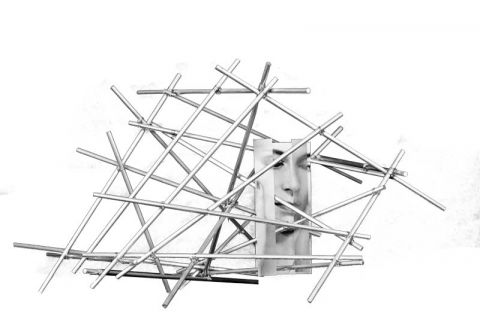New opportunities — the ones that aren’t part of my usual way of working but I find myself instinctively drawn to — can be a fantastic way to develop ones practice. The collage abuse series came about in this way, and another opportunity this week resulted in me transmuting one collage into a series of filmic stills. This flirt with film is definitely a first for me. It’s an approach which fractures viewing into small slices that gradually reveal a whole, an exercise both in giving and in withholding.
Sabine Kriebel voiced the opinion photographs are a witness to aging, capturing a moment that’s always past and anticipating the body’s passing.(1) The stillness of photography promotes the notion of death whereas film returns the dead to an appearance of life.(1) Given this, what does my approach deliver? Perhaps it creates a kind of half-life, incapable of animating the dead image in any way but able to animate and capture my viewing perspective as the artist and communicate it more readily and immediately to a willing spectator?
For me, the approach is yet another form of collage; something born out of disparate fragments recombined to make something new. However, to some extent, it’s a much more controlling mechanism that the original collage. I can’t control how someone looks at a picture on a wall, but a filmic approach fixes frame, order, and duration. Yes, the viewer may choose not to look at all, but if they do, they are subject to what I dictate.
I worked with a single collage, To accrete no5, and found spending time shooting it resulted in it giving up its most interesting angles, textures, tones, colour, and compositions. The experience felt like composing and painting through the mechanism of the camera.
I’m aware that the approach extends the shift of the raw materials across mediums — original photograph — to scanned digital information — to collaged physical object — back to photograph — finally ending in filmic stills. Obviously, there is no reason for the dislocation to stop here — it could continue endlessly.
My intention was to work with some logic — a flow of composition around the picture plane — but to pan in and out on different shots emphasising details and dislocating the viewing perspective from one still to another. I discovered lighting this multi-layered collage from above and to one side delivered far more dramatic results than the more traditional, even, illumination from both sides. The shots have been deliberately tweaked in Photoshop to emphasise drama and bring out extremes of contrast and focus.
This is my first foray into Windows Movie Maker. I found it pretty user friendly with nifty functions to animate the slide like crossfade and zoom. These allowed me to increase disjuncture, resulting in something with a constant gentle drift to the viewer’s left.
My goal is to create a fractured viewing experience that encourages careful looking and is more thought-provoking than simply encountering the still shot that reveals everything at one glance. I’d like it to begin by hinting at what’s on offer, revealing ‘truth’ only towards the end of the experience.
Let the audience judge if this is successful:
https://vimeo.com/89775077
http://clairemanning.co.uk/z_collage_abuse.html
1 Sabine Kriebel, ‘Theories of Photography; a short history’, in James Elkins, Photographic Theory, (Abingdon: Routledge, 2007), p.34.


